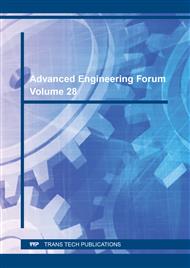[1]
S. L. Phoenix, P. K. Porwal, A new membrane model for the ballistic impact response and V50 performance of multi-ply fibrous systems, Int. J. Solids Struct., 40 (2003) 6723–6765.
DOI: 10.1016/s0020-7683(03)00329-9
Google Scholar
[2]
Y. Duan, M. Keefe, T. A. Bogetti, B. Powers, Finite element modeling of transverse impact on a ballistic fabric, Int. J. Mech. Sci., 48, (2006) 33–43.
DOI: 10.1016/j.ijmecsci.2005.09.007
Google Scholar
[3]
B. L. Lee, J. W. Song, J. E. Ward, Failure of Spectra® Polyethylene Fiber-Reinforced Composites under Ballistic Impact Loading, J. Compos. Mater., 28, (1994) 1202–1226.
DOI: 10.1177/002199839402801302
Google Scholar
[4]
N. K. Naik, P. Shrirao, Composite structures under ballistic impact, Compos. Struct., 66 (2004) 579–590.
DOI: 10.1016/j.compstruct.2004.05.006
Google Scholar
[5]
M. P. Flanagan, M. A. Zikry, J. W. Wall, A. El-Shiekh, An Experimental Investigation of High Velocity Impact and Penetration Failure Modes in Textile Composites, J. Compos. Mater., 33, (1999) 1080–1103.
DOI: 10.1177/002199839903301202
Google Scholar
[6]
J. N. Baucom, M. A. Zikry, Low-velocity impact damage progression in woven E-glass composite systems, Compos. Part Appl. Sci. Manuf., 36, (2005) 658–664.
DOI: 10.1016/j.compositesa.2004.07.008
Google Scholar
[7]
X. Wang, Low velocity impact properties of 3D woven basalt/aramid hybrid composites, Compos. Sci. Technol., 68, (2008) 444–450.
DOI: 10.1016/j.compscitech.2007.06.016
Google Scholar
[8]
C. Ha-Minh, F. Boussu, T. Kanit, D. Crépin, A. Imad, Analysis on failure mechanisms of an interlock woven fabric under ballistic impact, Eng. Fail. Anal., 18, (2011) 2179–2187.
DOI: 10.1016/j.engfailanal.2011.07.011
Google Scholar
[9]
E. Gellert, S. Cimpoeru, R. Woodward, A study of the effect of target thickness on the ballistic perforation of glass-fibre-reinforced plastic composites, Int. J. Impact Eng., 24 (2000) 445–456.
DOI: 10.1016/s0734-743x(99)00175-x
Google Scholar
[10]
S. Gürgen, M. C. Kuşhan, The ballistic performance of aramid based fabrics impregnated with multi-phase shear thickening fluids, Polym. Test., 64 (2017) 296–306.
DOI: 10.1016/j.polymertesting.2017.11.003
Google Scholar
[11]
S. Gürgen, M. C. Kuşhan, The stab resistance of fabrics impregnated with shear thickening fluids including various particle size of additives, Compos. Part Appl. Sci. Manuf., 94 (2017) 50–60.
DOI: 10.1016/j.compositesa.2016.12.019
Google Scholar
[12]
S. Gürgen, M. C. Kuşhan, The effect of silicon carbide additives on the stab resistance of shear thickening fluid treated fabrics, Mech. Adv. Mater. Struct., 24 (2017) 1381–1390.
DOI: 10.1080/15376494.2016.1231355
Google Scholar
[13]
S. Gürgen, M. C. Kuşhan, W. Li, The effect of carbide particle additives on rheology of shear thickening fluids, Korea-Aust. Rheol. J., 28 (2016) 121–128.
DOI: 10.1007/s13367-016-0011-x
Google Scholar
[14]
S. Gürgen, W. Li, M. C. Kuşhan, The rheology of shear thickening fluids with various ceramic particle additives, Mater. Des., 104 (2016) 312–319.
DOI: 10.1016/j.matdes.2016.05.055
Google Scholar
[15]
S. Gürgen, M. C. Kuşhan, Rheological Properties of Shear Thickening Fluids, J Polytechnic, 19 (2016) 409–414.
Google Scholar
[16]
S. Gürgen, M. C. Kuşhan, W. Li, Shear thickening fluids in protective applications: A review, Prog. Polym. Sci., 75 (2017) 48–72.
DOI: 10.1016/j.progpolymsci.2017.07.003
Google Scholar
[17]
M. H. Malakooti, H. S. Hwang, N. C. Goulbourne, H. A. Sodano, Role of ZnO nanowire arrays on the impact response of aramid fabrics, Compos. Part B Eng., 127 (2017) 222–231.
DOI: 10.1016/j.compositesb.2017.05.084
Google Scholar
[18]
H. Talebi, S. V. Wong, A. M. S. Hamouda, Finite element evaluation of projectile nose angle effects in ballistic perforation of high strength fabric, Compos. Struct., 87 (2009) 314–320.
DOI: 10.1016/j.compstruct.2008.02.009
Google Scholar
[19]
R. Barauskas, A. Abraitienė, Computational analysis of impact of a bullet against the multilayer fabrics in LS-DYNA, Int. J. Impact Eng., 34 (2007) 1286–1305.
DOI: 10.1016/j.ijimpeng.2006.06.002
Google Scholar
[20]
B. Gu, J. Xu, Finite element calculation of 4-step 3-dimensional braided composite under ballistic perforation, Compos. Part B Eng., 35 (2004) 291–297.
DOI: 10.1016/j.compositesb.2004.01.001
Google Scholar
[21]
R. C. Laible, Ballistic materials and penetration mechanics. Elsevier, (1980).
Google Scholar
[22]
P. Sriram, Ballistic protective clothing: An overview, Ind. J. Fib. Tex. Res., 22 (1997) 274–291.
Google Scholar
[23]
M. Miao, J. H. Xin, Engineering of high-performance textiles. Elsevier, (2018).
Google Scholar
[24]
S. Gürgen, M. C. Kuşhan, High Performance Fabrics in Body Protective Systems, Mater. Sci. Forum, 880 (2016) 132–135.
DOI: 10.4028/www.scientific.net/msf.880.132
Google Scholar
[25]
Y. Duan, M. Keefe, T. A. Bogetti, B. A. Cheeseman, Modeling the role of friction during ballistic impact of a high-strength plain-weave fabric, Compos. Struct., 68 (2005) 331–337.
DOI: 10.1016/j.compstruct.2004.03.026
Google Scholar
[26]
M. P. Rao, G. Nilakantan, M. Keefe, B. M. Powers, T. A. Bogetti, Global/Local Modeling of Ballistic Impact onto Woven Fabrics, J. Compos. Mater., 43 (2009) 445–467.
DOI: 10.1177/0021998308097684
Google Scholar


